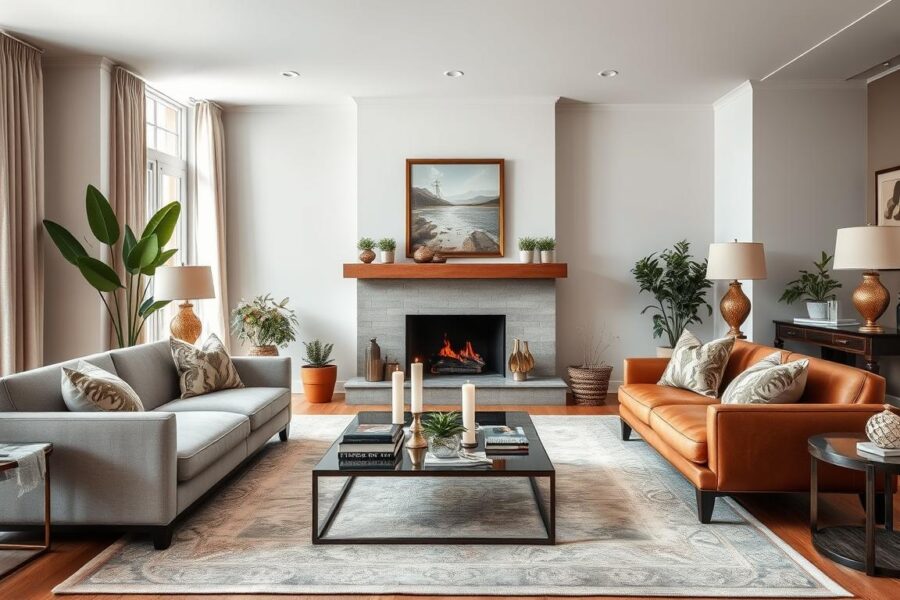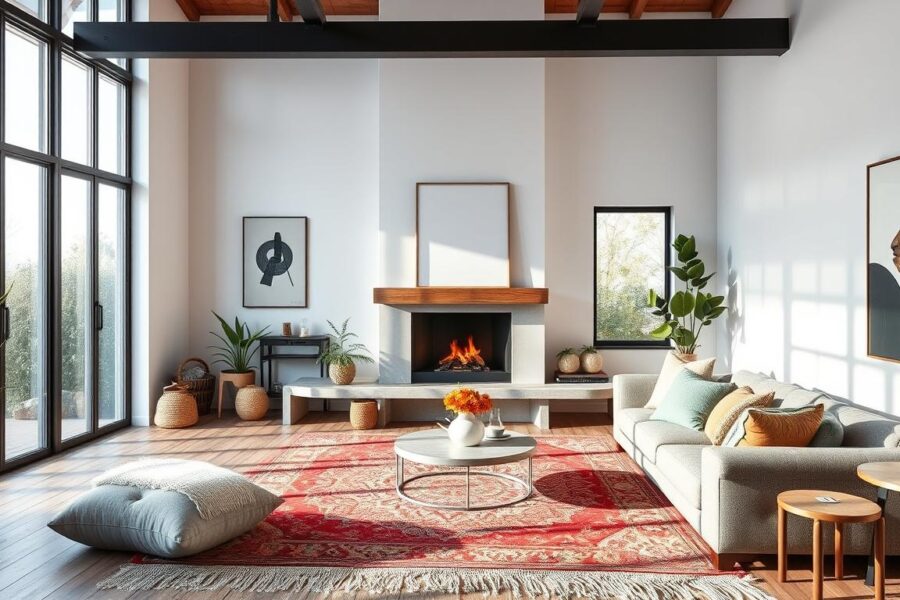This post contains affiliate links. Some images may have been created with the help of AI.
Are you ready to change how you live and entertain by removing walls? Open-concept living rooms are more than a trend. They turn homes into open spaces with modern designs that celebrate freedom and flow. But what if your open space feels too open? That’s where smart design comes in, offering 30 ways to make your living area beautiful and functional.
Over 1.5K people have shared their ideas on creating the perfect open-concept living room. Imagine a space with a cozy sofa, accent chairs, a colorful kitchen island, and mirrors and rugs that highlight different areas. With 70% of homeowners choosing neutral colors, you’ll find the perfect color scheme for your home.
It’s not just about looks. Sales of multifunctional furniture have risen by 30%. This shows that homeowners value furniture that looks good and works well. Plus, choosing unified colors and minimalist cabinets can make your home feel bigger and more organized.
This collection shows smart layout ideas and the importance of modern living. You’ll find tips on using glass for elegance and portable dividers for flexible spaces. It’s not just inspiration; it’s a path to a home that’s adaptable and charming. Let’s make the most of your space with ideas that are practical, save energy (up to 75%), and stylish.
Understanding Open Concept Living Rooms
Home design has changed a lot, moving towards open and inclusive spaces. The old barriers that used to divide homes are now gone. This shift is seen in open concept living rooms, which bring people closer together.
What is an Open Concept Living Room?
An open concept living room removes walls between the kitchen, dining, and living areas. This creates a single, flexible space. It makes moving around easier and encourages people to spend time together. Many people like these designs because they are open and easy to move through1.
Key Benefits of Open Concept Design
Open concept designs improve how we move around the home. They make it easier to get from one area to another2. They also let in more natural light, which is good for our health and saves energy21.
These rooms also offer great views without walls getting in the way. They help air circulate better, making the space feel fresher and more comfortable2. Families who live in these spaces often spend more time together, enjoying each other’s company1.
| Feature | Benefit |
|---|---|
| Enhanced social interaction | Creates a sense of community and togetherness |
| Better traffic flow | Smooth movement and less constrained environment |
| Increased natural light | Reduces need for artificial lighting, lowers energy costs |
| Unified view | Maximizes scenic views and enhances property value |
| Improved air quality | Promotes health through cross-ventilation |
Open-plan design makes homes look better and work better. It’s great for big gatherings or quiet family time. It also helps keep spaces tidy with smart storage, making them both useful and nice to look at2. With help from architects and designers, homeowners can make their open spaces perfect2.
Popular Layout Styles for Open Concept Spaces
Open concept spaces are great for both daily life and parties. They mix style with function, offering lots of room. The key is to plan well, balancing looks with use.
Traditional vs. Modern Open Concepts
Open floor plans can match anyone’s taste, blending old charm with new style. Traditional ones warm up spaces with comfy furniture and classic designs. On the other hand, modern ones are all about simplicity and flexibility, with clean lines and rooms that do more than one thing.
Brad Ramsey from Nashville says modern open concepts often combine kitchens and dining into one big area. This meets the need for spaces that are both fun and practical. Yet, Jerel Lake from Atlanta notes that some people still love the old-fashioned idea of separate rooms3.
Minimalist Design Approaches
Minimalism in open spaces is about making every piece count. It’s about choosing wisely, like 68% of designers suggest. This approach makes spaces feel bigger and calmer, without being empty.
But, it’s hard to keep these spaces cozy. Shea McGee says that families and those who love to entertain like rooms that do it all. They offer openness with the ability to do many things at once3.
Choosing between open and closed spaces depends on what you like and how you live. Open spaces are modern and airy, but need careful planning to avoid problems like noise and privacy issues4.
Zoning Your Open Concept Living Room
The trend of merging kitchens with living rooms is growing in modern homes56. To keep this look while making each area useful, zoning spaces is key.
Zoning lets you make different areas in one big space5. You can use different floors and rugs to mark off areas5. This keeps the room open but also makes each area its own.
Decorating with Area Rugs
Area rugs are great for dividing open spaces56. They help group furniture and make each area clear. Using rugs with different colors can also make each zone stand out6.
Furniture Placement Strategies
Where you put furniture is very important in open spaces5. Big pieces like sofas or screens can act as dividers5. You can also use sofas back-to-back or bookcases as dividers for both looks and storage5.
Movable screens or bookcases are great for changing the layout56. They help make each area work well together but still look good56.
Color Schemes for Open Concept Living Rooms
Choosing the right color scheme is key for open concept living rooms. These spaces need colors that help them look connected and feel open. The colors we pick affect how we see the space and its different areas.
Choosing a Cohesive Color Palette
Neutral colors are great for open floor plans. They make the space look smooth and big7. Shades like white, beige, gray, and taupe can make a room feel airy7.
For a touch of nature, consider green shades. They bring a calm, organic feel to the room8. This works well with different areas, where colors can subtly mark each space.
Accent Walls to Define Spaces
Accent walls are important for dividing a big room into areas. They add interest and create focal points without walls. A bold color like navy blue or emerald green can make a statement7.
Bolder colors like grass-green or orange can energize a space. They help define zones without blocking the flow8. Painting trim or crown molding the same color keeps the look consistent7.
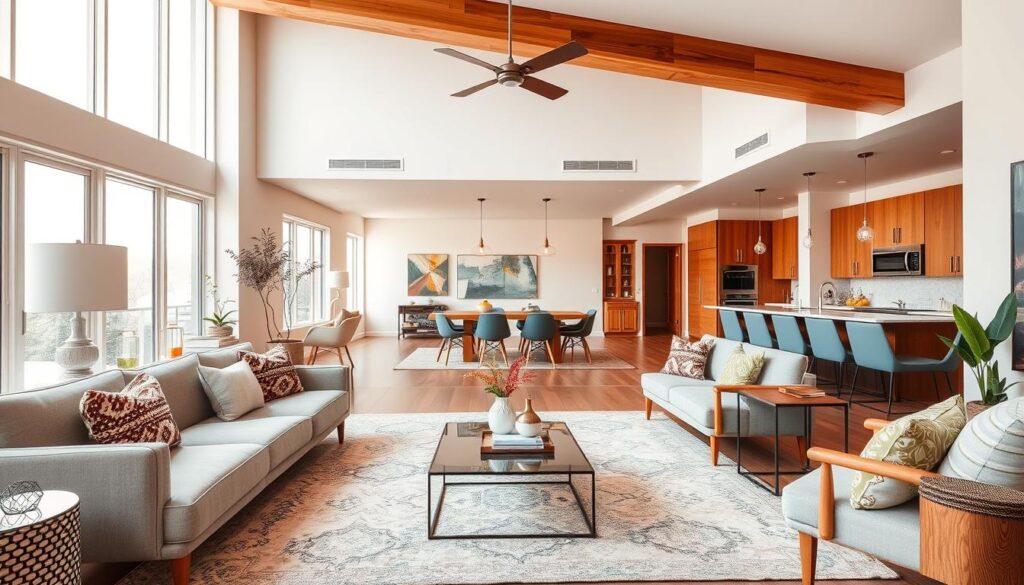
In summary, the color scheme for open concept living rooms should be balanced. It should define spaces gently while keeping the area connected. By picking the right shades and using accent walls, the space can be lively and unified.
Incorporating Natural Light
Spacious interiors with natural light are key in open-concept living areas. Large windows and skylights bring in daylight. This makes the space feel open and free.
Using Windows and Skylights
Windows and skylights are vital in open-concept designs. They let in lots of natural light and keep the flow smooth. Placing windows at different heights adds depth and interest to your home9.
Skylights bring in sunlight from above. This is great in living areas where regular windows don’t get enough light9.
The Impact of Mirrors in Open Spaces
Mirrors are crucial in open-concept spaces. Placing large mirrors near windows doubles the natural light. This makes the area brighter and more spacious9.
Mirrors also help define areas in the open space. They do this without using solid walls, keeping the flow smooth109.
Using these elements makes your open-concept living space lively and welcoming. It truly captures the essence of modern home design11.
Multi-Functional Furniture Options
Modern layouts are becoming more common in city homes. This means we need furniture that can do more than one thing. Such furniture not only fits well with modern designs but also makes small spaces more useful and attractive.
Choosing the Right Sofa
Finding the right sofa is key for a great living room. Sofa-cum-beds are popular for small rooms because they save space. They turn into beds easily, showing how furniture can meet different needs12.
Sleeper sofas are another example of furniture that does double duty. They show that furniture should be able to change its use1314.
Practical Solutions: Ottomans and Storage
Ottomans with hidden storage are smart choices. They act as footrests and storage, helping to keep things tidy14. Nesting tables also help with small spaces, adding flexibility without losing style or usefulness12.
Putting furniture like Murphy beds in the right spots can make a big difference. These beds fold into walls and turn into workspaces, making rooms more versatile1314.
Choosing furniture that’s simple and can be changed around is smart. It makes rooms look better and work better. This approach keeps the room looking good and functional, fitting well with modern design12.
When picking furniture, think about what you need and how much space you have. The right furniture can make small spaces better and improve life quality. It shows how smart design can make the most of any space13.
Creating a Flow: Open Living Room to Kitchen
The connection between a living room and kitchen makes an open-plan design more attractive. It’s important to have smooth transitions and a continuous flow. This makes the space both useful and welcoming.
How to Seamlessly Connect Spaces
Using the same color in both areas is key to a unified look. Having the same flooring in both spaces makes the area feel bigger and more connected15. Good lighting is also essential. It helps define the different zones and adds warmth, changing the mood15.
Choosing furniture that doesn’t block views is important. This keeps the room feeling open and connected15. Open-concept kitchens and living rooms have been popular since the 1970s. They offer a mix of practicality and style, appealing to many16.
Choosing the Right Barstools
When picking barstools, think about both looks and function. Barstools are not just for sitting but also help connect the cooking and social areas. They should match the room’s style and be strong enough for daily use. Brands like Asheville Cotton are known for their beauty and durability in kitchens17.
Every choice, including kitchen cabinets, affects the flow in open-plan designs. Cabinets from experts like At405 Cabinets and Stone add both beauty and function. They help the kitchen blend smoothly with the living room17.
To make an open-plan room work, keep it simple and choose furniture that fits the space. Too much stuff can make it feel cramped and less open15. Using rugs to define areas like dining or lounging helps keep things tidy and visually appealing. This way, each area is clear but still connected16.
Adding Personality to Your Space
Turning an open concept living room into a cozy space is more than just arranging furniture. It’s about adding elements that show off your style. Modern layouts make it easy to mix function with beauty, creating a perfect backdrop for your personal touch. Adding artwork, decor, and plants can make your space feel both unique and welcoming.
Personal Touches: Artwork and Decor
Artwork is a powerful way to make an open concept living room your own. The right art can be a centerpiece or connect different parts of the room. Using bold prints can change the room’s feel, making it stand out and look better18. Gallery walls are great for showing off your taste and telling your story through art18.
Integrating Plants and Greenery
Adding plants to your living room brings in color and life, making it feel warmer and more inviting. Plants can help separate areas without using walls, creating a smooth yet organized space. Big plants can act as natural dividers, while small ones add green touches everywhere18.
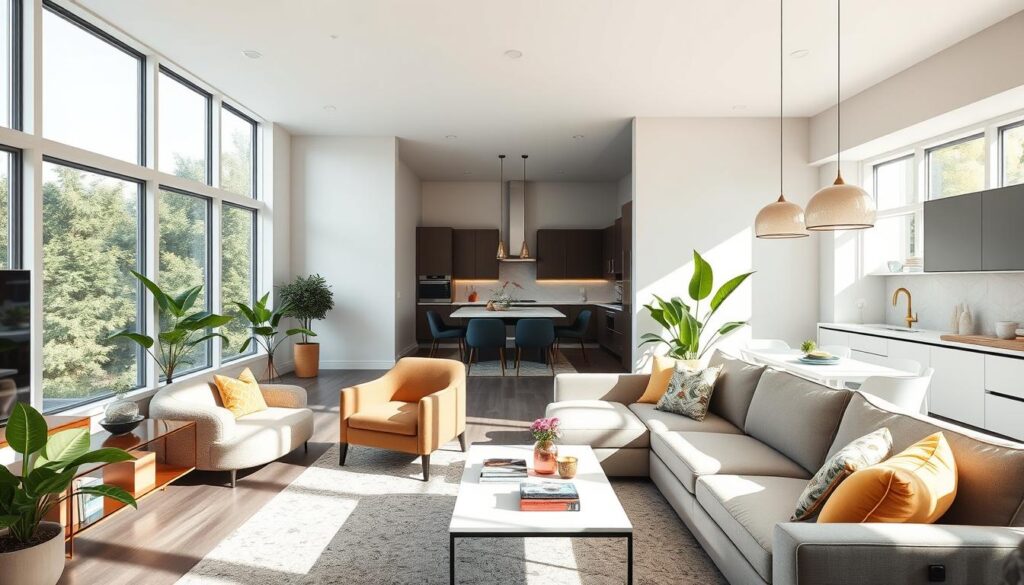
The secret to a great open concept living room is finding a balance. It’s about mixing big, open spaces with personal touches that show your style. By carefully choosing modern layouts, artwork, and plants, every part of your home can have its own story. This makes your living space more than just a house—it becomes a home.
Lighting Solutions for Open Concept Living Rooms
Lighting is key in making open concept living rooms look good and work well. A good lighting plan lights up the space and makes it modern. It’s all about layered lighting, which uses different lights in different ways to make the space lively and useful.
Layered Lighting Techniques
Layered lighting is a must in open concept living rooms. It changes with the day and what you’re doing. Ambient lighting lights up the whole room. Task lighting focuses on areas for things like reading or cooking. Accent lighting adds flair by highlighting special features or art.
Using these layers makes the room both beautiful and practical19.
Choosing Statement Lighting Fixtures
Choosing the right lighting fixtures is crucial for open concept living rooms. Big lights like chandeliers or pendant lights are not just for lighting. They also draw attention to themselves. Adding features that let you adjust the light makes the room even more versatile20.
| Lighting Type | Function | Ideal Placement |
|---|---|---|
| Ambient Lighting | General illumination | Ceiling-mounted fixtures, recessed lighting |
| Task Lighting | Focuses light on specific areas | Under-cabinet lights, desk lamps, pendant lights over kitchen islands |
| Accent Lighting | Highlights features | Wall-mounted fixtures, directed lamps |
In short, good lighting in an open concept living room needs a mix of different types. With ambient, task, and accent lighting, the room stays bright and looks modern. Adding stylish, functional fixtures makes any open space welcoming and cozy.
Maintaining Cleanliness and Organization
Living in an open-plan design means keeping your space tidy and organized. Many homeowners struggle with keeping their large areas clean. They need good strategies for staying organized and controlling their living space21.
Smart Storage Ideas
About 20 smart storage ideas can make an open-plan area neat and organized22. Built-in shelves or bookcases can solve 40% of storage needs, adding beauty and function22. Creative storage, like under-stair spaces or multi-use furniture, covers 20% of the tips. It combines style with practicality, using every inch of space22.
Storage is a big challenge in 70% of open concept homes. Built-in solutions and multi-use furniture are key. They save space and enhance decor23.
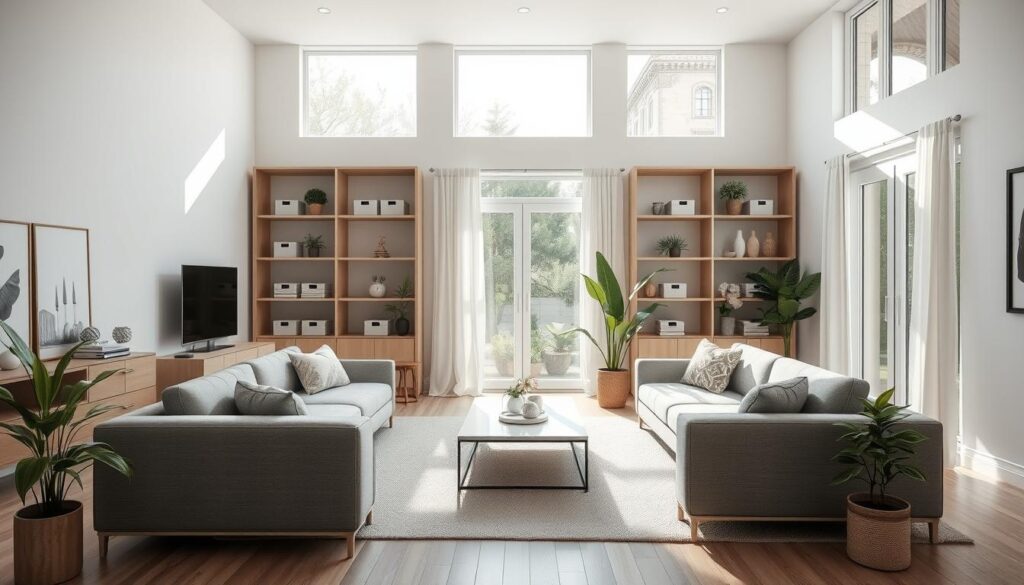
Decluttering Tips for Open Spaces
Decluttering is key to keeping an open-plan area feeling airy. Using baskets or containers, about 15% of tips, helps manage clutter22. Having a place for everything keeps your space neat and inviting. Matching colors and textures in decor can link zones without clutter, creating a cohesive look21.
To make the most of open-concept living rooms, think about both looks and function. Use a consistent color scheme and place furniture wisely for easy movement21. Adjust areas as needed by looking at them from different angles. This ensures each zone is balanced and well-connected21.
In short, keeping open-plan living areas clean and organized needs careful thought. Smart storage and a minimalist approach help. Homeowners can then enjoy the beauty and usefulness of their open-plan spaces.
Outdoor Integration with Open Concept Living
Bringing the outdoors into our homes is a big trend now. Open concept living rooms easily connect to patios and decks. This makes our living spaces more beautiful and useful.
In places like Sydney, people love to mix indoor and outdoor living. Big glass doors and bi-fold doors help make this easy. They look good and work well, making it easy to move between inside and outside.
Creating a Smooth Transition to Patios
Choosing the right design is key to a smooth flow between rooms. Using the same flooring and colors inside and out helps a lot. Bi-fold doors also make it easy to open up or close off spaces.
Using Bi-Fold Doors for Expansion
Bi-fold doors are a great choice for open concept living. They open up to connect indoor and outdoor spaces. This lets in more natural light, making your home feel better and more energy-efficient.
| Feature | Benefit | Example |
|---|---|---|
| Large Glass Doors | Enhanced natural light and views | Bi-fold doors in living rooms |
| Seamless Flooring | Uninterrupted flow between indoor and outdoor areas | Matching tile or hardwood extending to patio |
| Natural Elements | Aesthetic cohesion and stress reduction | Integration of native plants and water features |
| Versatile Furniture | Functional and durable for both settings | Weather-resistant sofas that mimic indoor luxury |
Adding outdoor heaters and awnings makes your space comfortable all year. This smart design improves your life and increases your home’s value.
Common Mistakes in Open Concept Design
Open-plan designs can make a home feel more connected. But, they also come with challenges. Over the last 20 years, more homes have open floors24. Yet, making these spaces work well is tricky.
Planning spaces carefully is key. Too much furniture or the wrong size can ruin the openness. It’s important to think about each area’s purpose and how they fit together25.
Overcrowding the Space
Many people want big, open homes but end up with clutter24. To avoid this, set up clear zones for different activities25. Placing furniture too close to walls can make a space feel cramped25.
Choosing the right furniture size is crucial. It helps keep the space open and makes moving around easier25.
Ignoring Scale and Proportion
Open spaces can look off-balance if not planned well. Small rugs can mess up a room’s look26. Using the same furniture everywhere can make a space look dull26.
It’s not just about filling the space. You need to choose items that fit the room’s size and style. Adding different textures and lighting can help26.


